|
Toa Payoh
Vets Clinical Research
Making veterinary surgery alive
to a veterinary student studying in Australia
using real case studies and pictures |
Buying Time
For An Old Companion - Circum-anal tumours -
Part 1
Dr
Sing Kong Yuen, BVMS (Glasgow), MRCVS
First written: 09 June, 2009
Update:
12 September, 2011 |
 toapayohvets.com toapayohvets.com
Be Kind To Pets
Veterinary Education
Project 2010-0129 |
|
First Consultation in June 2009 |
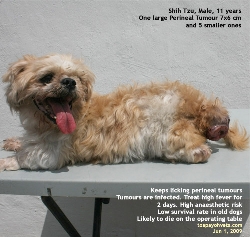 3
years ago, the first veterinarian consulted said, "Don't
operate. This dog would die before the tumour grows to a
large size as he is an old dog." The man in his 50s went
home. 3
years ago, the first veterinarian consulted said, "Don't
operate. This dog would die before the tumour grows to a
large size as he is an old dog." The man in his 50s went
home.
A year later, he consulted
another veterinarian in another practice as the tumour
had grown bigger in size. The second veterinarian said,
"Don't operate. The dog is old and may die under general
anaesthesia."
6 months ago, the tumours to
the left of the anus grew enormously to become the half
the size of a tennis ball. The dog licked the tumours.
The bacteria multiplied in the open sores of the tumour.
The smell of stinking flesh and oozing blood overwhelmed
the air inside the apartment. Unbearable smell of
rotting flesh. Blood drops stained the floor as the old
companion rubbed his backside vigorously and frequently
on the floor to relieve his pain and itchiness.
The man decided that it was time to put the 11-year-old
male Shih Tzu to sleep. Euthanasia by lethal injection.
"No," his grown up children
objected strenuously. "Why should the old dog die just
because he had a large tumour?"
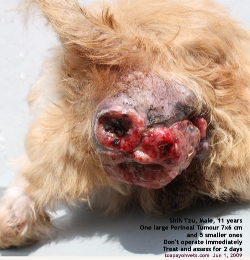 The
son-in-law was working opposite my Surgery. So that was
how I got to see this case in June 2009. The
son-in-law was working opposite my Surgery. So that was
how I got to see this case in June 2009.
"The dog is very thin," I had
a premonition that this dog was going to die during
anaesthesia . "He should be in good condition at his
age. Therefore, he may not be able to take the long
general anaesthesia and will die on the operating
table."
"He used to be chubby. My
children just would not permit me to get the vet to
euthanase him," the man in his 50s said.
High risk anaesthesia cases
usually die on the operating table. I could understand
that the first two veterinarians were not keen to
operate on the old dog. At that time, the perianal
(circum-anal) tumours were much smaller.
News about deaths on the operating table spread like
wild fire and kill the hard-earned reputations faster
than lethal injections. It is up to the owner to seek a
veterinarian who will operate. But inertia in this old
companion led to the explosive growth of the perianal
(circum-anal) tumours.
"I will try to fatten the dog
for 3 days before I operate," I said to the man. "Your
Shih Tzu has high fever. The cause would be bacterial
infections from this large tumour."
"OK," the man accepted the
risks and the poor surgical outcome. I had a bad feeling
about this case. At 11 years of age and in a poor body
condition, being very thin. My premonition was telling
me to reject this case. All vets will get deaths on the
operating table at one time or another. But this case
had a high probability of death and ought to be rejected
to save a hard-earned veterinary reputation that could be
bad-mouthed by the owner whenever a dog dies on the operating
table.
I put the dog was put on an IV
drip and antibiotics for the first 24 hours. He ate
little. His fever went down 36 hours later. He licked
his tumour hoping it would disappear by continual
licking.
He was likely to have a
perianal (circum-anal) adenocarcinomas. Fast growing.
Usually present in a non-neutered male dog.
Anaesthesia
On day 3, I started the
surgery with a negative mental attitude and a heavy
heart for this old companion who had endured so much
pain and rejections by two veterinarians who did not
want to risk their reputations operating on him.
I injected 0.2 ml of Zoletil
50 IM. The dog started to look skywards as his wry neck
forced him to turn his head at 90 degrees to his body.
Torticollis like chickens suffering from the viral
Newcastle Disease is an effect of Zoletil injection.
The reason I used Zoletil was
that xylazine caused vomiting and hypotension. This dog
was very old and in poor condition. Therefore I placed
my bets on Zoletil being safer for this old companion.
The dog's neck twisted
sideways and was tetanic. So the gas mask to knock him
down with 5% isoflurane gas could not be placed properly
and comfortably into this nose. Even if he was
anaesthesized, it would be extremely difficult to lift
up his head upright and intubate. What's the solution?
This is why a knowledge of
veterinary pharmacology comes in. Zoletil has this side
effect on dogs and I seldom use it for sedation. Zoletil
also cause great excitement in cats when given alone.
The cats dash here and there inside the crate. I saw one
rabbit behaving similarly.
The reason I used Zoletil was
that it would be a safer drug for this aged dog.
His neck remained twisted to
the side. What to do now? His tongue had gone maroon
red. Dark red.
The solution was to give him
atropine 0.5 ml IM. Will it work? After 2 minutes, the
dog's neck muscles relaxed and I could mask him
properly. He had no profuse salivation unlike one case I
did earlier. 99% of the time, I use xylazine as I had
been using it for more than 20 years. Zoletil is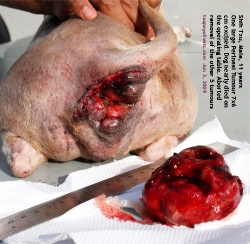 not a new drug and is very good for topping up as an
injectable anaesthetic in dogs where there is no general
anaesthestic gas facilities.
not a new drug and is very good for topping up as an
injectable anaesthetic in dogs where there is no general
anaesthestic gas facilities.
But now we are talking about
sedation. The dog had this side effect of "Torticollis"
if you don't give atropine 5 minutes before Zoletil or
at the same time.
In this case, the atropine
injection given later put the dog back to normal. So, I
started intubation when the dog fell asleep under
isoflurane gas delivered in the gas mask.
Everything should be routine,
I thought. My premonition was not justified.
Just as I had inserted the
endotracheal tube, a large amount of bubbles and fluid
flowed out of the endotracheal tube. As if the lungs had
lots of water. This was unexpected and never encountered
in xylazine sedation and induction in my past twenty
years. Vomitus from the stomach sometimes happened
during xylazine sedation on the operating table. But
clear bubbly water from the lungs started shooting out
fast and furiously. That was dangerous.
I pulled out the endotracheal
tube promptly. My assistant, Mr Saw quickly lifted the
dog by the back legs with the dog's head downwards. He
slapped the chest to get all the lung water out of the
lungs. Mr Saw was very prompt and experienced.
Now, what should I do? My bad
feeling about this case had returned. It was no wonder
that the other two veterinarians did not want to touch
this case. Should I abort the surgery now?
Abortion meant death for this
dog as the perianal (circum-anal) tumours were badly
infected and had many big holes due to continual licking
and traumatic damage from the floor. The dog needed
help. This was his last opportunity to live as the
pressure from the man in his 50s to euthanase him would
increase.
Gas mask anaesthesia
I put a big breed gas mask to
fit the head of this Shih Tzu. The mask had a
see-through wall and I could see the colour of the
tongue. The Shih Tzu breathed heavily. Soon he felt
asleep. His tongue colour was now reddish.
The surgery commenced. Nothing
eventful. The tongue colour started to fade. From red to
bluish and then half blue and half white. I monitored
the anaesthesia very carefully as gas mask anaesthesia
was not as efficient as intubation.
The surgery needed to be
completed faster. 30 minutes had passed. The tongue
started to whiten. Any more anaesthetic gas would stop
the heart beating. The dog's heart would. A cardiac
emergency. What to do now? There was no endotracheal
tube now to give emergency oxygen as the tube had been
filled with pulmonary fluid earlier and I had taken it
out.
What was the reason for the
tongue to turn white in colour?
I pressed the chest hard with
my palms to stimulate the heart to pump. An external
cardiac resuscitation using hand pressure. To get the
heart to beat so that blood could circulate. The
breathing had slowed considerably.
This was the twilight zone. Between life and death.
Should anaesthesia be given at all? If not, the dog
might feel the pain and struggled during the final
stages of tumour removal. If yes, the dog's heart might
fail. A dead dog on the operating table was not welcome
by the owner. What decision should I make?
What would you do? You had a
few seconds to decide.
I took away the gas mask and
the assistant continued cardiac massage. The dog was in
deep comatose sleep. His pupils had dilated 70% wide. At
death's door. He did not now experience pain. He was
going to die.
For the next 5 minutes and it
seemed it was an eternity, the large skin defect after
removal of the gigantic tumour was stitched. As fast as
possible.
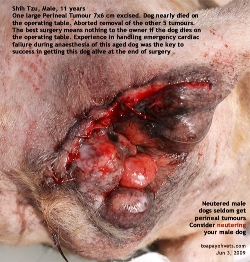 "Abort
the surgery," I said to my team. "The 5 smaller
satellite tumours around his anus would not be removed
today. It is better to have a live dog rather than a
dead one." "Abort
the surgery," I said to my team. "The 5 smaller
satellite tumours around his anus would not be removed
today. It is better to have a live dog rather than a
dead one."
Post-operation
The dog was conscious. So it
was good news. The inside of the cheek was snow white.
The tongue and gums had pale tinges of pink. Very light
pink. The dog was awake.
I gave an I/V drip now. Hartman's Solution I/V drip was
not given during surgery as the dog had an I/V drip for
24 hours prior to surgery.
I injected one vial of Lasix
into the IV drip. Baytril antibiotics were also given
into this I/V drip. The inside of the cheek was still
snow white. Why? The dog was alive and conscious. 50 ml
of the glucose was also given.
The dog was put in the crate.
He barked and barked at me. Glucose had revived him. I
was surprised at his vigorous barking. This old dog was
at death's door and now he was so busy and noisy. As if
he was communicating to me. To say that he was very much
alive. That he beat the odds. Never harbour negative
mental thoughts.
Going home
After 7 days of nursing, I
sent the dog home. His stitches had held up for 2 days
only. His 5 tumours appeared to have shrunk 20%.
I would not like to operate on
him again. Yet, if he could be neutered, it might be
possible that the 5 perianal (circum-anal) tumours might
not grow fast.
"You are buying time for this
dog," I said to the good son-in-law who discovered my
surgery by proximity to his office. How much time? It is
hard to say. If only the dog had been operated on when
the perianal (circum-anal) tumours were small. In this
case, two vets did not want to operate on him and the
owners did not seek out a vet who would perform the
surgery. I advised neutering some 2 weeks later. The
owner did not return.
Advices to owners
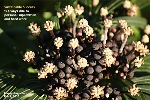 Owners will need to be
proactive and take tumours seriously in their beloved
old companion dogs. This dog was much younger at that
time and the tumour could be easily removed. Neutering
is highly recommended as this tumour is said to depend
on the male hormone testosterone to thrive and grow.
Neutered male dogs seldom suffer from perianal tumours
in old age. Owners will need to be
proactive and take tumours seriously in their beloved
old companion dogs. This dog was much younger at that
time and the tumour could be easily removed. Neutering
is highly recommended as this tumour is said to depend
on the male hormone testosterone to thrive and grow.
Neutered male dogs seldom suffer from perianal tumours
in old age.
Some vets don't like to
tarnish their reputation with surgeries on old dogs.
Some vets do not want to do surgery as it is very
difficult to close the big wound after excision of the
tumour.
It is up to the owners to do their homework and find a
veterinarian who will operate on small circum-anal
tumours. In this case, there was a second opinion which
was similar to the first - "Don't operate. The dog would
die before the tumour would grow bigger." Unfortunately
for the two good-intentioned vets,
the tumours outlived the dog in the sense that the dog
was still alive as the tumours grew by leaps and bounds, like
a tsunami wave, causing daily bleeding soiling the apartment.
In conclusion, owners had
to be proactive as regards their personal health as well
as that of their dog. Large tumours cost over $1,000 in
veterinary fees as they require lots of time and medication.
Always get small tumours (less than 1 cm in diameter) operated
by our vet early. If your vet is not so keen on the surgical
excision of circum-anal tumours, seek other vets. You will
save a lot of money if you just be proactive.
|
|
Update in February & June 2010 |
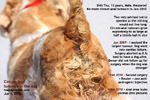 Buying Time
For An Old Companion - Circum-anal tumours -
Part 1 Buying Time
For An Old Companion - Circum-anal tumours -
Part 1
Circum-anal tumours - Feb & Jun 2010 - Part 2 |
|
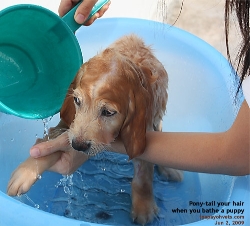 Advert for Veterinary Technicians Advert for Veterinary Technicians
or Nurses For Toa Payoh Vets |
|
BE KIND TO OLDER DOGS & CATS --- GET TUMOURS
REMOVED EARLY --- WHEN THEY ARE SMALLER.
More case studies, goto:
Cats or
Dogs |
|
|
To
make an appointment: e-mail
judy@toapayohvets.com
tel: +65 9668-6469, 6254-3326 |
 toapayohvets.com toapayohvets.com
Be Kind To Pets
Veterinary Education
Project 2010-0129 |
|
|
 Toa
Payoh Vets Toa
Payoh Vets
Clinical Research
|
|
|
Copyright ©
Asiahomes Internet
All rights reserved. Revised: September 12, 2011
Toa Payoh Vets |
|
 TOA
PAYOH VETS
TOA
PAYOH VETS TOA
PAYOH VETS
TOA
PAYOH VETS